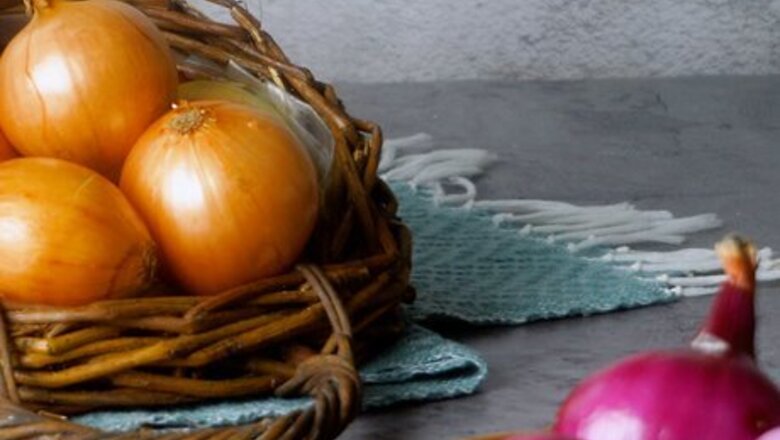
views
Curing Onions for Winter Storage

Choose pungent onions. Mild onions do not cure well, so when you want to air dry or cure onions for winter storage, pungent onions are a better choice. As a general rule, mild onions care usually quite large and have paper-like skins the are easy to peel. When cut open, the onions are juicy and the rings are fairly thick. Pungent onions are notably smaller in size and tend to have tight skins. When cut open, the rings will be notably thinner and your eyes will likely begin to water. Mild onions will only last, dried or cured, for a month or two at most. In contrast, pungent onions can last all winter in ideal conditions. The sulfurous compounds that cause tears to form in your eyes when you cut a pungent onion also slow down the rotting process. Popular varieties of pungent onions include the Candy, Copra, Red Weathersfield, and Ebenezer.
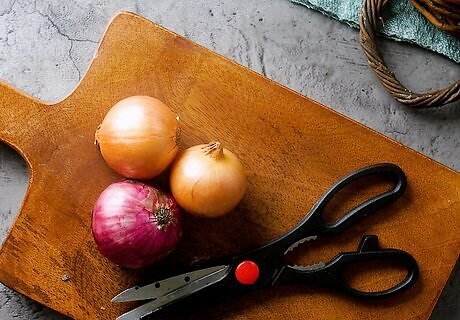
Trim off the leaves. Snip away any shriveled leaves with scissors or shears and gently clean off the roots by brushing off any large clumps of soil. This step is only necessary if the onions have been harvested from your garden. If you are buying them from the store, odds are, the leaves and dirt have already been removed. Note that the onion should only be harvested after the leaves on the plant have begun to weaken and "flop" over, indicating that the plant has stopped growing. Only fully matured onions should be cured for winter storage. Note that you should also dry or cure your onions as soon as you harvest them for best results.
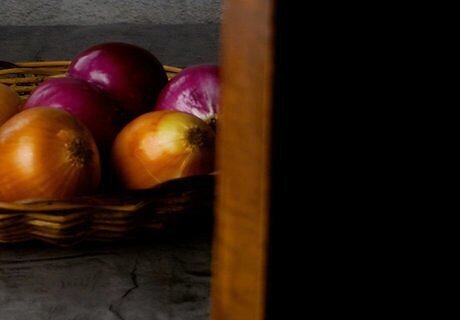
Transfer the onions to a warm, protected area. Place the onions in a single layer in a shed or pantry with temperatures ranging between 60 degrees Fahrenheit (15 degrees Celsius) and 80 degrees Fahrenheit (27 degrees Celsius). Let the onions cure in this initial stage for a full week. If the weather outside is still dry and warm, and you do not need to worry about animals getting into your onion crop, you can usually let them lay in the garden for the first few days. Usually, though, you will need to move them into a garage, shed, or covered porch. Be careful as you move the onions. They can bruise if you bump them together too roughly. You should also avoid touching them during this initial drying stage. Do not place the onions in direct sunlight since doing so can cause uneven drying.
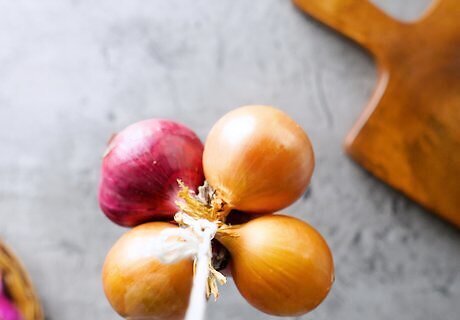
Consider curing the onions in a braid. You can either finish curing the onions by laying them out flat, but you could also finish curing them by weaving the tops into a braid. Braid the onions together by trimming off all the leaves aside from the three newest. Tie or braid these remaining leaves to the leaves of other onions being cured and hang them vertically to finish drying. Note that this is typically a matter of personal preference or space constraints since, according to research, onions do not do better or worse whether they dry braided or laid out flat. Allow the onions to cure in this manner for a total of four to six weeks.
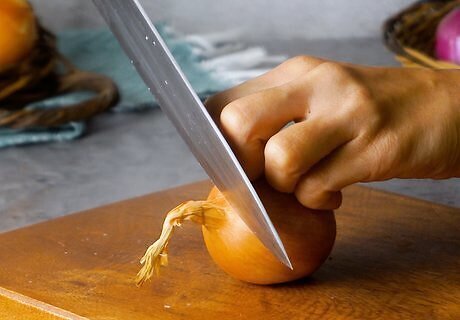
Trim back the tops. As the onions cure, you should trim back the tops two or three times as the stem shrinks. Cut the rest of the necks off when the onions have cured completely. The roots should also be trimmed off. Trim the tops back two or three times during the curing process. After the onions finish curing/drying, cut the necks off completely. After the first week or two of drying, you should also use scissors to trim the roots of the onion to 1/4 inch (6 mm).
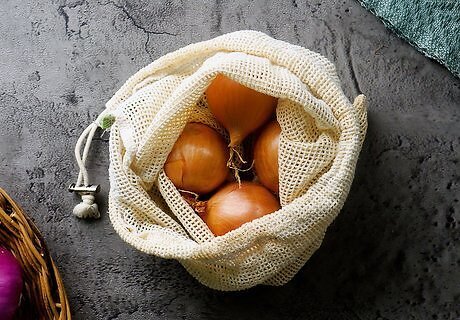
Store the onions in a cool, dry place. During the winter, for instance, you can usually keep the onions in your basement. Place the onions in mesh bags, a bushel basket, or a flat cardboard box with holes punched into it. Only place three onions or so into a small space so that they have plenty of air circulation. At a temperature of 32 degrees Fahrenheit (0 degrees Celsius), pungent onions can last for 6 to 9 months and mild onions can last two weeks to one month.
Oven Drying

Preheat the oven to 140 degrees Fahrenheit (71 degrees Celsius). Prepare two or more baking sheets by lining them with parchment paper. On average, you will need one to two standard baking sheets for every one onion you intend to dry using this method. If you are only drying one onion, prepare two baking sheets. If you are drying two onions, prepare three or four baking sheets, and so on. It is better to give the onions too much space than to provide too little. Do not allow the temperature to rise above 140 degrees Fahrenheit (71 degrees Celsius) during the drying process. If the oven does rise above this temperature, you may end up burning or dry-roasting the onion instead of drying it. The trays you use should be about 2 inches (5 cm) narrower than the inside of your oven to provide sufficient air circulation.
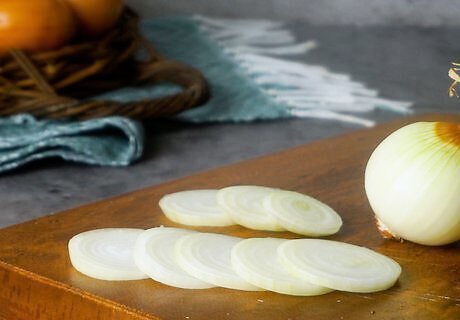
Cut the onions into thin slices. The root, top, and skins should be removed, and the onions should be chopped or sliced into 1/4 or 1/8 inch (6.35 or 3.175 mm) rings. The easiest way to slice onions for this purpose is to use a mandoline. If you do not have this particular kitchen utensil, though, you could also slice the onions as thin as possible using your sharpest kitchen knife.
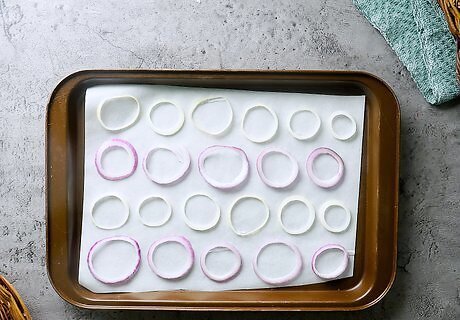
Spread the onions out onto the baking sheets. Transfer the onion slices to your prepared baking sheets and spread them out in a single layer. If you pile the onions onto a baking sheet, they will take longer to dry and may dry unevenly when all is said and done. This could create problems later on if you accidentally store a few onions that have not been thoroughly dried.

Dry the onion in the preheated oven. Place the onion in the oven and dry them for 6 to 10 hours, turning the trays as needed to minimize the risk of scorching. If possible, keep the door of the oven propped open with a 4-inch (10-cm) gap or so to prevent the inside of the oven from getting too hot. If you do this, you may also want to position a fan at the opening to force the air inside to circulate more effectively. Keep about 3 inches (7.6 cm) of empty space in between trays and in between the top tray and the top of the oven. There needs to be plenty of air circulation. Keep a close eye on the onions as they near the end of the drying process since they may end up scorching if left inside the oven too long. Scorching can ruin the taste and make the onions less nutritious.
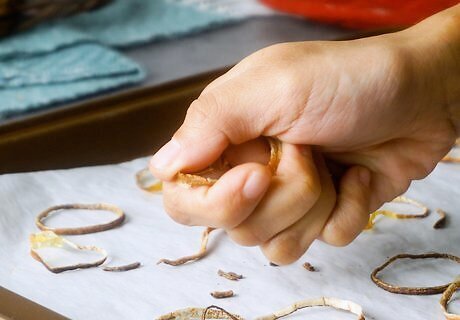
Crumble when done. When done, the onions will be brittle enough to crumble with your hands. You can create onion flakes in this manner. For onion flakes, only crush the onions likely with your hands. For onion powder, place the onions in a plastic bag and roll over them using a rolling pin. You could also leave the onions slices whole, but note that they will be brittle and delicate, so they can break apart easily if handled roughly.

Store in a cool, dry place. Place the onion flakes in an airtight container and store in a pantry cupboard or similar storage area. If vacuum-sealed, dried onion can last for up to 12 months. In slightly less airtight conditions, the onions can last anywhere from 3 to 9 months. Watch out for moisture. If you spot any moisture inside the container during the first few days of storage, take the onions out, dry them further, and dry the container before placing them back in. Moisture can cause the dried onions to spoil faster.
Dehydrator Technique
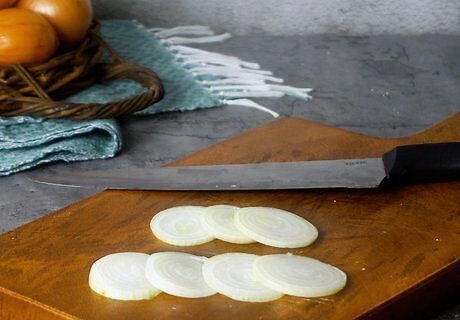
Prepare the onions. The onions should be peeled and sliced into rings that are 1/8 inch (3.175 mm) thick. Cut off the root end of the onion and peel off the skins. Use a mandoline to slice the onion if you have one, using the smallest or second smallest setting available. If you do not have a mandoline, using your sharpest kitchen knife to cut the onion as thin as possible.
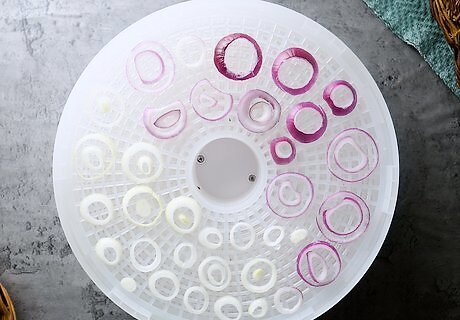
Place the onions onto dehydrator trays. Arrange the onion slices onto your dehydrator trays in a single layer, positioning the trays so that they can receive plenty of air circulation. The onions slices or rings should not overlap or touch. Keep them fairly spread apart to maximize air circulation. The trays should also positioned far apart within the dehydrator. Keep at least 2 to 3 inches (5 to 7.6 cm) of space in between trays to maximize circulation.

Run the dehydrator for about 12 hours. If your dehydrator has a thermostat, run it at 145 degrees Fahrenheit (63 degrees Celsius) until the rings dry. If you have an older or cheaper dehydrator that does not have a thermostat, you need to monitor the drying time more closely. The amount of time might need to be increased or decreased by an hour or so, and you can monitor the temperature with an oven-safe thermometer to gauge how big a time difference you need to account for.
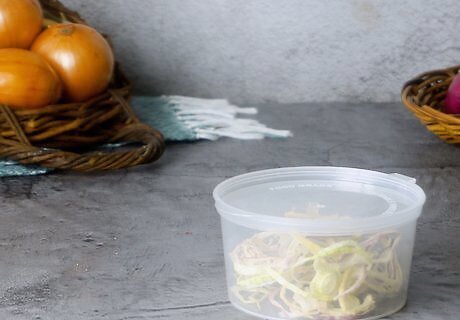
Store the dried onions in an airtight container. Keep the onions in a cool, dry location. Use them in your cooking or eat them plain. If you vacuum seal the dried onions, they can last for up to 12 months. In slightly less airtight conditions, the onions can last 3 to 9 months. Watch out for moisture. If you spot any moisture inside the container during the first few days of storage, take the onions out, dry them further, and dry the container before placing them back in. Moisture can cause the dried onions to spoil faster. You could also crush the onions into flakes or powder for culinary purpose.
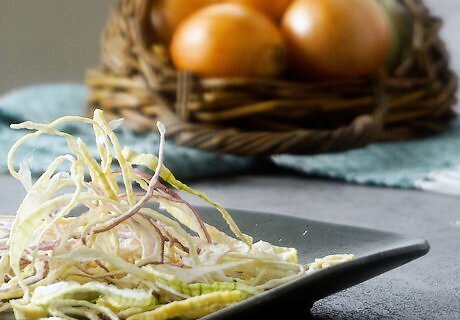
Finished.




















Comments
0 comment